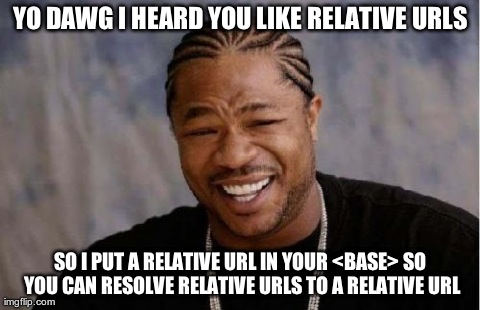@thatemil I’ve always considered style guides/pattern libraries to be unit tests for HTML+CSS, and you could automate them with JS if they get too unwieldy.
thatEmil i have heard html is important for that web thing
#TIL that you can put a relative URL in <base> (via Tantek Çelik)
If you want to generate real PDFs from HTML (i.e. with page breaks and real text, not just vast screenshots inside a PDF) then wkpdf is the way to go. Super fast, installs easily, great output.
Laura Kalbag my current pet peeve is a h1, then a h2 directly below it which is not a header, just a paragraph the author wanted to make look bigger (or a subheader, like bootstrap does with the downright weird h1 -> small). I saw it once a while ago, now I’m seeing it everywhere :/
Really Google? em to embolden search terms in results listings? #html
Cross-browser selection UI injection flow:
- Listen for
mouseuponbody - When triggered, let s be
window.getSelection() - If
s.isCollapsed === false, return - Else, let r be
s.getRangeAt(0) - Create a new element e
- Call
r.surroundContents(e) e.innerHTMLande.textContentnow return useful values, and e’s coordinates can be used to inject UI into the page
To resolve: what element should e be? Or more accurately, what display property should it have? Possibly inline-block (inline mucks up if selection is across block elements, block mucks up selections within text nodes)
r.surroundContent, namely that it does not handle partial element selections. See MDNs explanation and solution.
aral oh so you're suggesting it'd be a Boolean attr? That I could get behind – easy to polyfill too.
aral I disagree, "continue" is confusing compared to start. Start = start from a number, continue = what? Continue from a number? So the list should start from that number plus one? Or continue from another ol (perhaps by using an id reference)?
Rolled out usage of the menu element on #taproot. I’m looking forward to more browser support for HTML context menus, that will really open up the possibilities for cross-browser extensions
To all exeter_web people who saw my #microformats talk last night: I documented my usage of µf on my own site, hopefully it’s a useful real–world reference if you’re interested in using µf2 yourselves :)
@idiot loving “He was
:).content, but was he .happy?”
Forget HTML5. I’m working in HTML+ from now on!
I have to say I am very impressed with @twitter’s tweet embedding HTML. Progressive enhancement + graceful degradation at it’s best.
This is a fantastic HTML5 game — very clever gameplay: http://www.currantcat.com/convergence/
What’s the point of HTML5 nice table syntax if you can’t use it in ATOM feeds? Bah.
??? the marquee tag has JS methods?! Was it not bad enough already?
The more I read about HTML tables, the more I feel using them for layout wasn’t doing them justice :|
Something I learnt just now: HTML <ins> and <del> have datetime attrs for keeping track of changes.
This is handy as I’ve been wondering about those for a while. Interestingly they have a cite attr too (to a URL describing changes made) w
 Emil Björklund
Emil Björklund
 Laura Kalbag
Laura Kalbag Visual Idiot
Visual Idiot